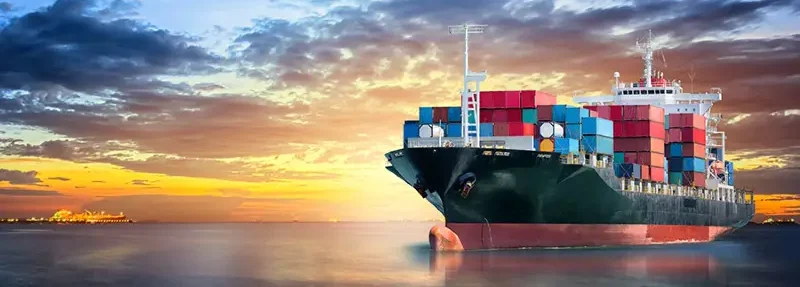Sea change for sea freight — Exporter Magazine

These are challenging times for shipping companies worldwide as they grapple with profitability and over-capacity issues. Meanwhile, landside, export businesses are facing exacting new rules around container weighing. Welcome to the never-boring world of sea freight.
By Glenn Baker.
Stand on any of Auckland’s North Shore beaches and observe a fully laden container ship steaming majestically through Rangitoto Channel, and you’d never know just how much logistical planning it took to achieve that rather stunning outcome.So much rests on those stacked containers reaching their intended destination; directly and indirectly the hopes, dreams and livelihoods of pretty much all of us depends on it.Let’s face it – consigning goods by container ship is unquestionably the most efficient way to get goods to world markets, but ensuring their smooth passage requires sophisticated systems and highly experienced professionals.To put it bluntly, sea freight is… well, complicated.So what are the issues causing shipping lines, and therefore shippers, the most angst right now?Well, firstly, if you work in freight and logistics, you should be very familiar with a new requirement by the International Maritime Organisation (IMO), the UN agency responsible for the safety and security of shipping, that from I July, 2016 shippers must ensure that the weight of every laden export container is verified using one of two methods:• Weighing the entire packed and sealed container, or• Calculating the container’s gross weight by weighing the contents and adding the container’s tare weight.The verified weight (known as Verified Gross Mass or VGM) must be provided to the shipping company in time for preparation of the vessel stowage plan. Without it, the shipping company and terminal won’t be allowed, by law, to load the container.Mike Knowles, shipping manager for Zespri International and chairman of the New Zealand Shippers Council (NZSC), says his organisation worked with Maritime New Zealand, IMO and the Global Shippers Forum on the new ruling for two years to ensure that it has a workable option for its members. “We took a leadership position in this development phase of the policy and are now part of the steering committee formed by all the major industry participants, to ensure that the implementation phase of the ruling goes as smoothly as possible.”His advice for shippers is to check out the NZSC website for direction; all the relevant links are there. “It’s important that they have a system in place by July 1st.”From a shipping line perspective, Maersk Line New Zealand managing director Gerard Morrison says the VGM requirement shouldn’t present any challenge in terms of changing their systems to capture the container data. “However, the challenge will obviously come when we receive bookings that don’t have the required information. Legally we won’t be able to process them.”Morrison says the new process will inevitably add time and cost to the whole equation, but any associated issues are pretty much specific to the shipper.“We can help point people in the right direction for information, but it’s not a condition that’s on shipping lines, it’s on the shippers.”Knowles says climate change will have a very real impact on shipping in the future too. At last year’s Paris Conference the IMO was charged with bringing the world’s shipping into line with other industries. The intention is to make shipping, including container ships, more efficient and carbon friendly, but the jury’s still out on how that can be accomplished.“There was an initial proposal to put a levy on bunker fuel, which could be unfair to a trading nation like New Zealand. Ninety-nine percent of our exports are shipped by sea freight,” says Knowles. “Our concern is that any levy would be passed on to exporters through higher freight rates rather than being used to drive carbon efficiencies within shipping.”Recent dredging initiatives at ports, such as Port of Tauranga, in preparation for larger (up to 7,500 TEU) container ships, also raises issues around connections with coastal shipping, protecting corridors in and out of ports, traffic congestion, and noise issues.
“In the bigger picture, if the government wants to double exports by 2025, our ports and the supply chain need to be working efficiently,” says Knowles, adding that the development of inland ports by some of the Ports’ companies has been good for competition, provides additional choice for exporters, and enhances supply chain efficiencies.
Worldwide issuesLooking at worldwide shipping issues that are impacting on New Zealand’s trading firms, the big one is the current over-capacity in container shipping.In the drive to bring unit costs down, bigger ships are being built. But the knock-on effect is that freight rates have collapsed, says Knowles, and shipping companies have been losing major money which brings into question the sustainability of some services. “One answer involves the consolidation of shipping companies, and that’s happening already.”“There’re moves underway internationally to rationalise capacity,” he adds, “and hopefully that will result in sustainable services.”Maersk’s Gerard Morrison says he’s never seen changes happening as fast as they are now in terms of demand in different parts of the world. He agrees that profitability, or lack thereof, is a major challenge facing shipping lines. Container and volume growth globally is very slow, so capacity versus volume is an issue. He says the goal for shipping lines is to match their cost base with the commercial environment. “Scale helps cost, so the bigger ships are not all of the problem; the bigger problem we’re facing is the levels of volume growth, particularly out of China.”Having said that, he says the arrival of larger 18,000 TEU and 20,000 TEU ships do impact on New Zealand. “It certainly has a knock-on effect in terms of what tonnage ships are available in certain marketplaces. The positive effect, however, is that certain size vessels that were previously very hard to get hold of now become more readily available.”Morrison says they’ve squeezed every available cost out of their business model, and going forward, technology will have a major role in creating additional efficiencies.Overall, the biggest challenge for shipping companies like Maersk is the price they’re receiving for their product. Morrison says it’s driven by “some pretty ordinary supply and demand pictures.”“Globally, over the past six to 12 months in particular, the supply and demand picture changes so fast that it requires shipping lines to make short-term decisions on their networks. If you have a ship that’s going to be only ten percent full, then you have to find another cost-effective way of managing that cargo. Low demand triggers changes to networks and rotations that can sometimes impact on shippers.”There are the unexpected issues to deal with too, such as the recent port strikes in Australia and the East Coast of the US – every shipping company’s nightmare. And the requirement to move to low sulphur fuels for port operations at certain ports around the world is being taken extremely seriously by Maersk, says Morrison. “We appreciate the size of our business and its impact on the planet and we have very detailed plans, targets and results in place towards reducing our environmental footprint. To date we’ve been extremely successful.”There are positives out there in the world’s shipping lanes too. A major game changer for sea freight, says NZSC’s Mike Knowles, is the opening of the Panama Canal extension later this year to allow ships of up to 14,000 TEU capacity to navigate the canal.“This should enhance services, and provide better capacity for New Zealand firms up to the US East Coast.”
More options
When looking at local logistics options, Maersk’s Morrison believes the situation has never been better for shippers and exporter firms in terms of who to work with, where to route cargo, where to store it and, of course, how to get it in and out of New Zealand.“I’ve never worked in a marketplace with so many options, and those options are developing all the time.”Having so many individually owned deep sea container ports is good for competition across the country’s regions, he says, but, while admitting he’s no expert on the subject, he does question some of the duplicity that exists. “There are lots of similar [facilities] being developed, which must mean there’re multiple levels of investment going on. For example, there are scenarios where inland hubs, developed over recent years by the ports, are right next door to each other.“But overall, from an exporter or shipper’s perspective there’re plenty of options, ways of doing things, and plenty of competition – and those three factors are critical to a good environment for exporters.”As for ease of doing international business, shipping lines are playing their part too. Morrison says Maersk has developed their website to make life easier for customers. “Just as many other industry sectors have done, we’re developing as many online or e-tools as we can to put more control in the hands of customers and reduce the amount of direct interaction with us. We’re also automating and digitising as much as possible.“Many of our customers will have an expectation, if they don’t already, that it should be no harder to process a shipment of goods than it is to buy something online from the likes of Amazon.”He’s seen the generational shift in their customers in recent times, and the associated change in expectations. “That requires us to fundamentally change our internal business processes, and we’re well into a multi-year project to achieve this.”Again this is where technology comes to the rescue with solutions, he says. It’s not easy for humans to understand all the different shipping regulations in the world’s jurisdictions, but computers can be easily programmed to deal with them.
“Efficiency’s very important to us as a business, particularly in today’s commercial environment, but only if it makes life easier for our customers.”
Advice for exportersMike Knowles’ advice for new and fledgling export firms is to, first, make sure they’re geared up for the arrival of the VGM requirement on July 1st, “or their containers won’t even get onto the port let alone onto a ship”.If you’re shipping perishable goods, it’s imperative to partner with a reliable shipping provider with fast transit times, good schedule integrity including if using trans-shipment, good connections through these hub-ports such as Singapore.“If you’re exporting dry goods you still want schedule integrity,” he says.Morrison urges exporters to do their homework. “Make sure you understand what it is that you are trying to procure or buy.“And talk to the experts. It’s an incredibly fragmented industry; a difficult one to get your head around even though it seems relatively simple.“There are a lot of processes involved with global shipping, and we’re trying hard to see how much of it we can eliminate. It’s quite antiquated in terms of the way documentation works and shipments are processed; and it does require some understanding of how it all works.”Morrison says Maersk has a team of 83 advisors based in Auckland, primarily there to talk to and help customers regarding sea freight matters.Despite the challenges the sea freight industry is currently facing worldwide, and the country’s distance from markets, both Knowles and Morrison are upbeat about the shipping industry’s future in New Zealand.“New Zealand produces a lot of food and natural resources that the world increasingly needs, so despite the flat market worldwide for consumer goods, our cargo base is growing,” says Knowles.
“Global trade in perishable goods is growing by around three percent per year, but New Zealand’s growth rate is even higher.”
Publishing Information
Magazine Issue
Exporter issue 41 Autumn 2016







